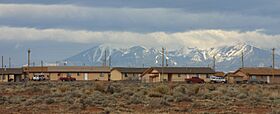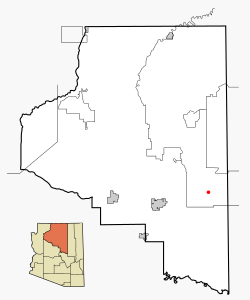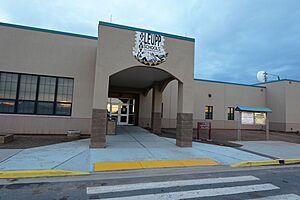Leupp, Arizona facts for kids
Quick facts for kids
Leupp, Arizona
|
|
|---|---|

Leupp, looking west to the San Francisco Peaks
|
|

Location in Coconino County and the state of Arizona
|
|
| Country | United States |
| State | Arizona |
| County | Coconino |
| Area | |
| • Total | 13.56 sq mi (35.12 km2) |
| • Land | 13.55 sq mi (35.10 km2) |
| • Water | 0.01 sq mi (0.02 km2) |
| Elevation | 4,754 ft (1,449 m) |
| Population
(2020)
|
|
| • Total | 934 |
| • Density | 68.91/sq mi (26.61/km2) |
| Time zone | UTC-7 (MST) |
| ZIP code |
86035
|
| Area code | 928 |
| FIPS code | 04-40630 |
| GNIS feature ID | 2408602 |

Leupp (pronounced LOOP) is a small community in Coconino County, Arizona. It's located on the Navajo Nation, which is the largest Native American reservation in the United States. In 2020, about 934 people lived there.
Back in 1902, a special school for Native American children was built in Leupp. It was a boarding school, meaning students lived there. Later, during World War II, this school was used as a place to hold Japanese and Japanese-American people. These people were sent there from larger camps if they were seen as causing problems or were trying to get their rights back.
Contents
Leupp's Past: A Look at Its History
The Navajo people and their ancestors have lived in this area for thousands of years. In 1868, the United States government made an agreement with the Navajo. This agreement set up a special area for them called a reservation. At first, this land was part of the New Mexico Territory. Later, in 1912, Arizona and New Mexico became states, and the reservation stretched across both.
The Indian Boarding School
In 1902, the Bureau of Indian Affairs (BIA) opened an Indian boarding school in Leupp. This school was for Navajo and other Native American children. Because families lived far apart, most children stayed at the school as boarders. Soon after, the school moved a few miles southeast to a new spot called Old Leupp.
Leupp as a Center of Activity
In 1907, the BIA made Leupp the main office for the Leupp Indian Land. This was one of five areas managed by the BIA for the Navajo people before they formed their own government in 1936.
The Leupp Trading Post
- In 1910, a man named John Walker built the Leupp Trading Post. It was made from sandstone and was located in the new community of "Old Leupp."
- The BIA was building its main office for the Navajo lands there.
- By 1912, Walker sold the trading post.
- In 1929, Stanton K. Borum and his wife Ida Mae bought the trading post. They made it bigger, adding a second floor where they lived. The trading post was on the first floor.
- In 1944, William E. and Lucile McGee bought the post. They had been in the trading business since 1923.
- Their son, Ralph, and his wife, Ellen, took over the business in 1968. They ran the Leupp Trading Post until 1982.
- Later, the trading post closed. The building was taken apart so its materials could be used elsewhere. Today, only the foundation remains.
Leupp During World War II
During World War I, some American soldiers from the Choctaw and Cherokee tribes used their languages as a secret code. This helped them send messages that the enemy couldn't understand. But before World War II, the Germans learned some of these languages. So, the U.S. decided not to use them again in Europe.
A man named Philip Johnston grew up near Leupp. His parents were missionaries, and he learned some of the Navajo language. During World War II, Johnston, who was an engineer, suggested to the Marines that they use the Navajo language as a secret code against the Japanese. He knew the language was very difficult for outsiders to learn.
The Navajo language is so complex that it took the Navajo code talkers only about 2.5 minutes to translate and send a message. This same message would have taken soldiers using other codes many hours to complete. Because Johnston grew up in this area, he knew the Navajo people and their language. This connection helped the U.S. in the war. The Navajo code was never broken by the enemy. The U.S. government kept it a secret for many years after the war ended.
The Leupp Isolation Center
During World War II, the U.S. Army took over the empty Bureau of Indian Affairs boarding school in Leupp. They turned it into the Leupp Isolation Center. This center was used to hold Japanese American people who were considered "troublemakers" by officials at other internment camps.
The first people sent to Leupp came from the Manzanar Isolation Center. In December 1942, there was a conflict between camp guards and Japanese-American prisoners at Manzanar. Two prisoners died, and others were hurt.
- Sixteen men believed to have started the protests were taken from Manzanar. They were held in local jails without being charged or having a hearing.
- Officials then prepared a former Civilian Conservation Corps camp in Utah to hold these "noncompliant" Japanese Americans.
- The 16 men from Manzanar arrived in Utah in January 1943.
- Over the next three months, 25 more men were sent there. Most of them had refused to take a "loyalty oath" that was confusingly worded.
- On April 27, 1943, most of these prisoners were moved to Leupp.
- More prisoners were sent to Leupp from other camps like Tule Lake and Topaz.
- Leupp usually held about 50 to 60 prisoners at a time. In total, about 80 Japanese Americans were held there.
- On December 2, 1943, the 52 prisoners still at Leupp were moved to a different camp at Tule Lake.
- The Leupp camp officially remained open but was not actively used until September 20, 1944. After that, it was given back to the Department of the Interior.
Leupp's Location and Climate
Leupp is located about 45 miles (72 kilometers) southeast of Flagstaff. The area covers about 13.56 square miles (35.1 square kilometers). Most of this area is land, with a very small amount of water.
Climate in Leupp
Leupp has a semi-arid climate. This means it's generally dry, with not a lot of rain.
Who Lives in Leupp?
| Historical population | |||
|---|---|---|---|
| Census | Pop. | %± | |
| 2000 | 970 | — | |
| 2010 | 951 | −2.0% | |
| 2020 | 934 | −1.8% | |
| U.S. Decennial Census | |||
In 2000, there were 970 people living in Leupp. Most of the people living there were Native American (98.1%). A small number were White or from other backgrounds. About 1% of the population was Hispanic or Latino.
Many households in Leupp had children under 18 living with them. The average household had about 4 people. The median age of people in Leupp was 23 years old, which means it's a relatively young community.
Learning in Leupp: Education
Children in Leupp attend schools that are part of the Flagstaff Unified School District (FUSD).
- Leupp Public School is an elementary school for students from kindergarten to 5th grade. As of 2018, all students at this school were Native American. This school also serves children from nearby communities like Birdsprings and Tolani Lake. It is the only FUSD school located on the Navajo reservation.
- For middle school, students go to Mount Elden Middle School.
- For high school, students attend Flagstaff High School.
There is also another school called Leupp Schools, Inc.. This is a boarding school managed by the Navajo Nation. It gets its funding from the Bureau of Indian Education (BIE).
Famous People from Leupp
- Marilou Schultz (Navajo), a talented textile artist and math teacher.
See also
 In Spanish: Leupp para niños
In Spanish: Leupp para niños




